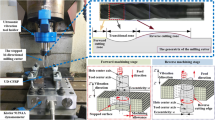Abstract
In the present work, we studied the slotting process of carbon fiber-reinforced plastic (CFRP) material with segmented helix tool. Measurements of transverse and longitudinal surface roughness, cutting efforts, and consumed power are carried out for different combinations of cutting speed and feed per tooth in order to evaluate the influence of the cutting conditions on the machined surface quality and energy consumption. Transverse (correspondingly longitudinal) roughness refers to roughness measured perpendicular to the advance direction (correspondingly in the advance direction). Scanning electron microscope (SEM) images have been taken in order to see closely surface topography and damages that occur to the machined surface. From the results, it was found that longitudinal roughness values depend on cutting conditions which is not the case for the transverse roughness and feed per tooth makes the highest statistical and physical influence on surface roughness, cutting force, and the consumed power values. SEM images showed the presence of four different material removal mechanisms that can cause damage to the matrix or/and fibers and may generate an increase in roughness measurements.
Similar content being viewed by others
References
El-Hofy MH, Sooa SL, Aspinwalla DK, Simb WM, Pearsonc D, Hardend P (2011) Factors affecting workpiece surface integrity in slotting of CFRP. Procedia Engineering 19:94–99
Hocheng H, Puw HY and Huang Y (1993) Preliminary study on milling of unidirectional carbon fibre-reinforced plastics, Composites Manufacturing Vol. 4 No 2
Paulo Davim J, Reis P (2005) Damage and dimensional precision on milling carbon fiber-reinforced plastics using design experiments. J Mater Process Technol 160:160–167
Ghidossi Patrick (2003) Contribution à l’étude de l’effet des conditions d’usinage d’éprouvettes en composites à matrice polymère sur leur réponse mécanique, thesis, ENSAM
Janardhan Prashanth. Tool wear of diamond interlocked tools in routing of CFRP composites, thesis, Faculty of the graduate school of Wichita State University, December 2005
Konig W, Grab P (1989) Quality definition and essessment in drilling of FRP thermosets. Annals of CIRP 38(1):119–124
Takeyama H, Iijima N (1988) Machinability of glass fiber reinforced plastics and application of ultrasonic machining. Annals of CIRP 37(1):93–96
Gara S. (2016) Approche théorique et expérimentale du détourage d’un composite en carbone/époxy moyennant des fraises à dentures croisées, thesis, Ecole Nationale d'ingénieurs de Tunis, Tunisia
Wang DH, Ramulu M, Wern CW (1992) Orthogonal cutting characteristics of graphite/epoxy composite materials. Trans NAMRI/SME 20:159–165
Wern CW (1991) Surface characteristics of machined graphite/epoxy composite, MS thesis, University of Washington
Ramulu M, Wern CW, Garbini JL (1993) Effect of the direction on surface roughness measurements of machined graphite/epoxy composite. Compos Manuf 4(1):39–51
Jamal SA, Urban N, Cheraghi H (2012) Machining damage in edge trimming of CFRP. Mater Manuf Process 27:802–808
Gara S, Tsoumarev O (2015) Effect of tool geometry on surface roughness in slotting of CFRP. Int J Adv Manuf Technol. doi:10.1007/s00170-015-8185-9
Durao Luis MP, Magalhaes AG, Marques AT, Baptista AM, Figueiredo M (2008) Drilling of fiber reinforced plastic laminates, Materials Science Forum, vol 587–588. Trans Tech Publications, Switzerland, pp 706–710
Durao Luis MP, Gonçalves DJS, Tavares JMRS, Albuquerque VHC, Marques AT, Baptista AM (2010) Drilling of carbon fiber reinforced laminates- a comparative analysis of five different drills on thrust force, roughness and delamination, Materials Science Forum, vol 636–637. Trans Tech Publications, Switzerland, pp 206–213
Gonçalves Daniel JS, Durao Luis MP, Tavares Joao Manuel RS, Albuquerque VHC, Torres Marques A (2010) Evaluation of tools and cutting conditions on carbon fibre reinforced laminates, Materials Science Forum, vol 638–642. Trans Tech Publications, Switzerland, pp 944–949
Vijay Kumar N, Gokul Nathan G, Krishnaraj V, Sasidharan G (2013) Effect of tool geometry in drilling of aerospace materials, Int J Sci Eng Res, 4(8)
Schornik V, Dana M, Zetkova I (2015) The influence of the cutting conditions on the machined surface quality when the CFRP is machined. Procedia Eng 100:1270–1276
Takeshi Y, Takayuki O, Hiroyuki S (2013) Temperature measurment of cutting tool and machined surface layer in milling of CFRP. Int J Mach Tool Manuf 70:63–69
Puw HY, Hocheng H (1998) Chip formation model of cutting fiber-reinforced plastics perpendicular to fiber axis. J Manuf Sci Eng 120(1):192–196
Turki Y, Habak M, Velasco R, Vantomme P, Aboura Z (2011) Etude expérimentale du détourage d’un composite carbone/époxy, 17ème colloque national de la recherche dans les IUT, CNRIUT, 8–10 june. Cherbourg-Octeville, France
Vinayagamoorthy R, Rajeswari N (2012) Analysis of cutting forces during milling of natural fibered composites using fuzzy logic. Int J Compos Mater Manuf 2(3):15–21
Gara S, Ramzi Fredj, Sami Naîmi and Oleg Tsoumarev (2016) Prediction of cutting forces in slotting of multidirectional CFRP laminate, Int J Adv Manuf Technol, DOI 10.1007/s00170-016-9161-8
Wang H, Sun J, Li J, Lu L, Li N (2016) Evaluation of cutting force and cutting temperature in milling carbon fiber-reinforced polymer composites. Int J Adv Manuf Technol 82(9):1517–1525
Author information
Authors and Affiliations
Corresponding author
Rights and permissions
About this article
Cite this article
Gara, S., Tsoumarev, O. Theoretical and experimental study of slotting CFRP material with segmented helix tool. Int J Adv Manuf Technol 94, 687–699 (2018). https://doi.org/10.1007/s00170-017-0830-z
Received:
Accepted:
Published:
Issue Date:
DOI: https://doi.org/10.1007/s00170-017-0830-z




